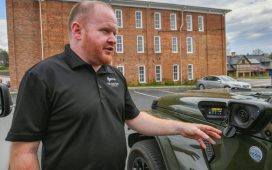
Electric cars charge up at a Tesla electric vehicle charging station at Gateway Shopping Center in Marin City, Calif., on Thursday, Aug. 26, 2021. (Alan Dep/Marin Independent Journal)
The Transportation Authority of Marin board has voted to accept a framework to accelerate the transition to electric vehicles, in some cases faster than required under state law.
The “Marin Countywide Electric Vehicle Acceleration Strategy,” developed by the interagency Marin County Climate and Energy Partnership, is meant to provide a playbook of policies and actions for jurisdictions to employ to ready their communities for a growing number of electric vehicles.
Several Marin communities have already accepted the strategy, and the Transportation Authority of Marin board did so on Thursday. The authority is a state-managed congestion management agency that also provides rebates to public agencies for installing charging stations and electrifying their vehicle fleets.
Christine O’Rourke, sustainability coordinator for the partnership, said some of the most important recommendations in the strategy are to have cities and towns require all new multifamily developments to have charging stations for all residents.
About 71% of the residences in Marin are single-family homes, which mostly have the ability to charge electric vehicles at home.
“The greatest need is for shared private chargers in multifamily buildings and workplaces,” O’Rourke told the board.
For existing multifamily buildings, the report is calling on local governments to increase the number of public electric vehicle chargers near these structures.
In Marin, there are 542 public and 484 shared private chargers, 83 of which are fast-charging stations known as “level 3” stations, according to the California Energy Commission.
Derek McGill, planning director with the Transportation Authority of Marin, said installing chargers at existing developments is more difficult compared to newer developments. He said there is a greater need for chargers in southern Marin.
The chair of the authority, San Anselmo Councilmember Brian Colbert, emphasized the recommendation to have Marin communities share information on what strategies work.
“If anyone manages to crack the code about retrofitting multifamily homes in Marin, please share, because the points of friction are huge and numerous,” Colbert said.
Additionally, the strategy calls for jurisdictions to replace gas-powered vehicles in their fleets with all-electric vehicles by 2030. California is requiring all new cars sold in the state to be 100% electric-powered beginning in 2035.
Overall, the report covers four approaches: accelerating the development of public charging stations; electrifying government fleets; outreach and education; and supporting legislation for electric vehicles. Different jurisdictions can pick and choose which strategies they want to adopt, a choice that comes with an associated work plan.
“The strategy is not a one-size-fits-all plan,” O’Rourke told the board.
So far, O’Rourke said, she has presented the plan to city officials or councils for Corte Madera, Larkspur, San Rafael, Mill Valley, San Anselmo, Novato, Sausalito and the county government. She plans to present to Belvedere in the near future and is waiting to hear from Ross.
Transportation Authority of Marin commissioners discussed and asked questions about some of the hurdles for local governments to enact these strategies, including limitations of the existing power grid and costs.
McGill said the Pacific Gas and Electric Co. grid capacity is “the elephant in the room,” especially when it comes to constraints on the construction of fast-charging stations.
O’Rourke said communities can plan for increasing funding for electric vehicle facilities through their capital budgets as well as in future bond measures.
Warren Wells, policy and planning director for the Marin County Bicycle Coalition, said that while the playbook includes information on the barriers to electric bicycle adoption, he said it lacks recommendations on how communities can address these issues. One of these issues is for cities to provide secure, off-street bicycle parking.
“We believe our new housing in Marin needs to not only be EV-ready but e-bike-ready,” Wells told the board.
A copy of the strategy can be found online at bit.ly/3EXMXsR.










